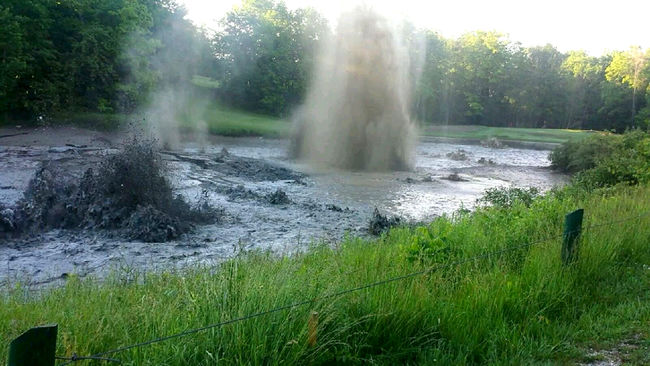Confirmed Naturally Occurring Gas Leak

Analysis confirms gas leak at Lambton Shores golf course is naturally occurring
An analysis of the geysers of gas that continue to burst from a Lambton Shores golf course’s creek has determined that the situation is not the result of human pollutants, but rather a natural phenomenon.
The amount of gas subsided substantially after the initial eruption last Wednesday, but has since plateaued and continues to bubble.
“What we’re hearing from the experts is that it’s still about the same as it was on Friday (June19). It hasn’t changed much at all,” said Doug Cook, deputy mayor of Lambton Shores.
“At this point there is not a definite way (to stop the leak). These experts don’t have any solutions to it right now. It’s a wait and see at this point.”
The localized state of emergency that the municipality declared for the Indian Hills Golf Club remains in effect, Cook added. The golf course remains closed until further notice.
Since the golf course is owned by the Kettle and Stony Point First Nation, it is up to them to hire and pay for environmental consultants to determine the cause of the gas leak. The First Nation purchased the course in 2006 and had hoped to make it part of the reserve by 2016.
Lorraine George, the First Nation’s manager and chief executive officer, said these consultants have determined air quality beyond the initial “hot spot” at the golf course is good and any traces of metals and gas in the water has since subsided, though hasn’t been totally eliminated.
There is currently no risk to public safety, she said.
The two hired consultants from Sarnia environmental firm Pollutech meet “almost daily” with the Municipal Emergency Control Group, George said.
The group includes officials from the First Nation and Lambton Shores as well as representatives from the provincial Ministry of the Environment and Ministry of Natural Resources.
Meetings often run late into the evening and occur on weekends as new issues arise. George said, “It’s been an excellent process” in that sense.
In addition to ongoing air and water testing, the contracted environmental workers began reviewing seismic readings for the area on Wednesday in the hopes of determining the gas leak’s cause.
“We don’t know what’s going on under the ground. Until we know that, we don’t know what the long-term solution is,” George said.
Union Gas responded to the leak last week and quickly determined that there were no pipelines in the area, so the leak must be coming from somewhere else.
A Ministry of Environment review of the area found no possible man-made pollutants that could be the source of the methane gas leaking out of the creek. The review ruled out the only possible source, a nearby sewage treatment plant, early on, according to Kate Jordan, a ministry spokesperson.
Naturally occurring gas leaks that slowly seep or bubble out of the ground are not uncommon, according to Maurice Dusseault, a professor of engineering geology with the University of Waterloo’s department of Earth and Environmental Sciences.
Since the gas is invisible, he said, it is only noticeable if it bubbles out of water. A naturally occurring gas leak geysering out of a creek, however, is very unlikely.
“My natural proclivity would be human-sourced,” he said. “But a naturally occurring natural gas emission suddenly like that? Very, very rare.”
While the initial ministry review of the area did not reveal any old oil wells, Dusseault said these may be the likely culprit, though he couldn’t say for sure without reviewing the scientific data.
“There’s been all kinds of energy wells punched down over the years in Ontario and they don’t even know where they all are,” he said. “Many of these wells are improperly sealed by today’s standards.”
A spokesperson for Union Gas, an interview last week, said she was only aware of one other naturally occurring natural gas leak in Ontario over the last 15 years.
The golf course has experienced more than a loss of business. Besides the initial eruption there are “golf holes” George said. These mini eruptions, some substantial, most the size of a golf ball, dot across several greens on the course.
For now the First Nation has assumed the cost of the consultants and is looking into making an insurance claim for the hiring and golf course reconstruction costs.
“We don’t only need to figure out why it happened but also if there is the potential for it to re-occur,” George said.
via Analysis confirms gas leak at Lambton Shores golf course is naturally occurring | Sarnia Observer
